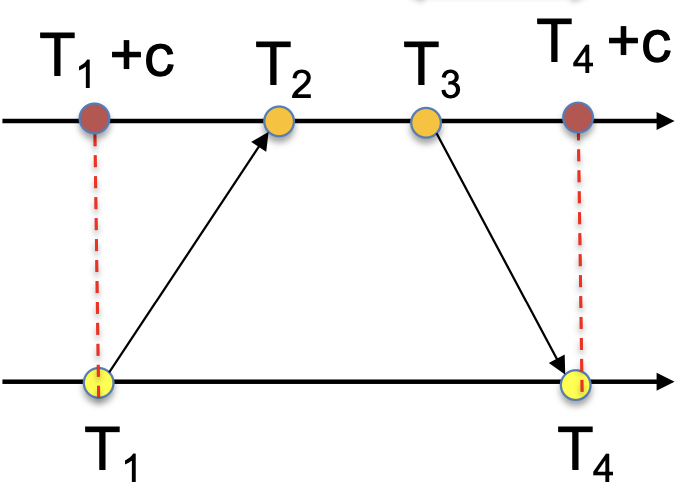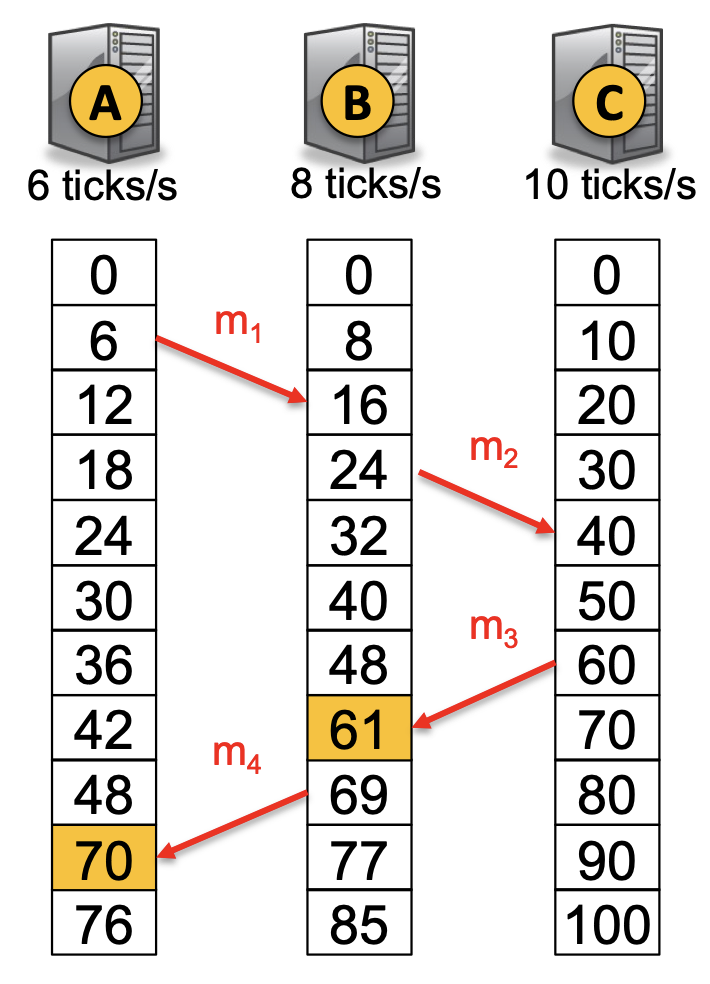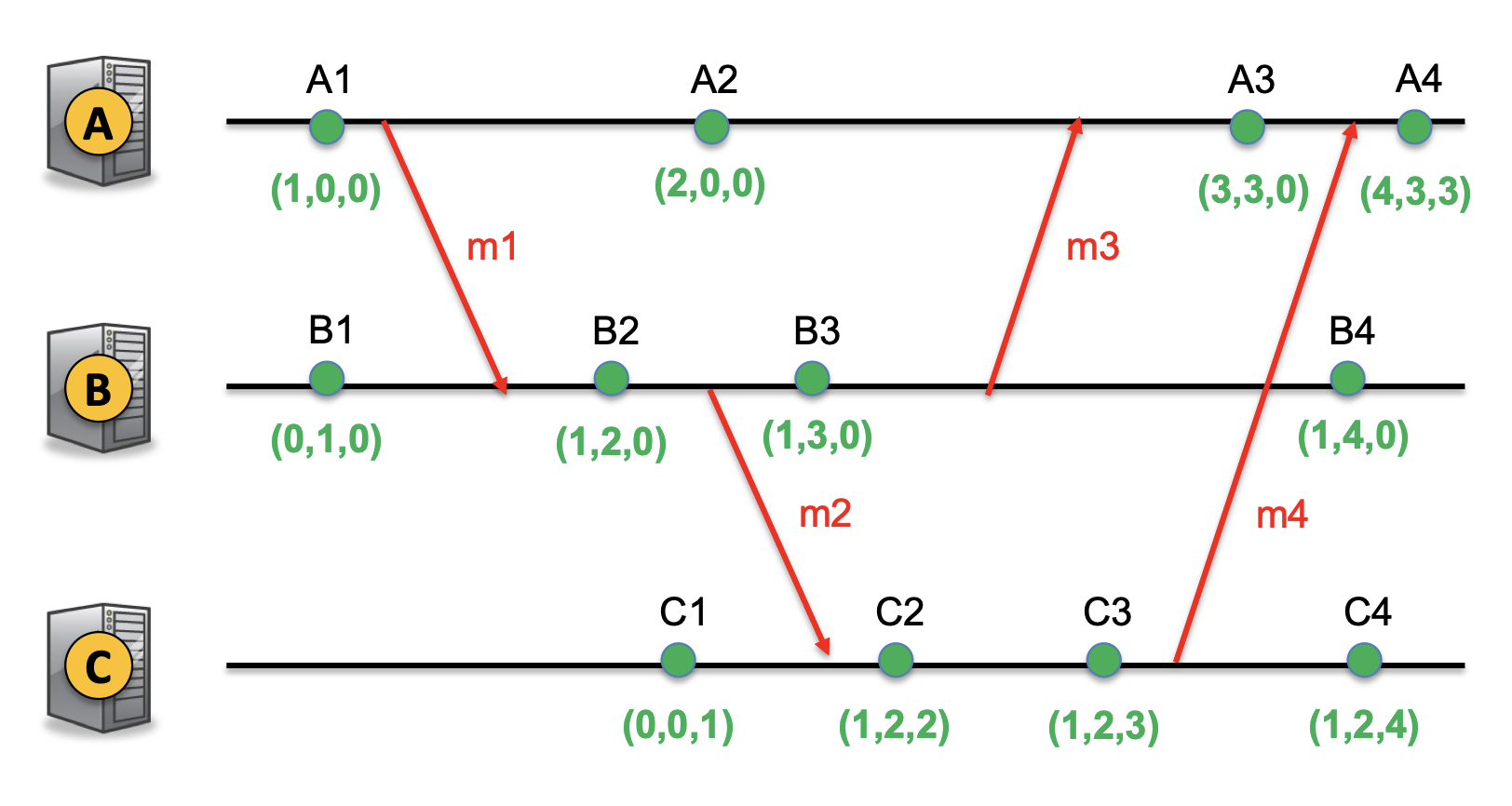Clocks are very useful for a variety of applications (timestamps, deadlines, timeouts, etc.), and generally every machine has a built-in time source. However, the local clock isn’t perfect and will drift—run too slow or too fast—due to finite precision and manufacturing variances.
In a distributed system with multiple nodes and multiple clocks, the drift will cause nodes to have slightly different times—clock skew. This can cause complications for the system; for example, file timestamps will be different across machines, causing confusion.
Thus, we need to synchronize the clocks across nodes; depending on the system’s demands, there are different types of synchronization we can do:
- Absolute time: wall-clock time, needed for things like scheduled execution.
- Logical time: an ordering of events—which one happened first?
NTP
The Network Time Protocol (NTP) is a synchronization algorithm, system architecture, and protocol for synchronizing clocks. The goal is to have one node, the “time server,” that knows the correct time—based on WWV shortwave radio signal or GPS signals, both of which contain the UTC standard—and have other nodes synchronize to the time server’s clock. The key difficulty is that communication between nodes will take time, and we need to account for it.
In NTP, a synchronization request between a node and the time server collects four timestamps: request transmission

Then, we compute estimates for the time offset to the server,
and the round trip time (RTT),
Based on this, we know that the correct time upon receiving the response is
Note that the interaction above is pairwise between the time server and node, which isn’t scalable; for larger systems, we introduce a strata/hierarchy of NTP servers that synchronize across layers. Note that higher strata doesn’t necessarily have better accuracy—it also depends on which servers the node synchronizes with and also the precision of the time source itself.
Finally, NTP has three synchronization modes:
- Procedure-call mode: one server accepts requests from others (as described above).
- Multicast mode: one or more servers periodically multicast their time into the network, and receivers set their clock assuming some small delay.
- Symmetric mode: a pair of servers exchange messages to improve the accuracy of their synchronization. This is used in lower levels of the strata and has the highest accuracy.
Berkeley Algorithm
In the case that no machine is a good time source, we can still synchronize clocks by averaging them periodically. Since drift is random, we hope that they’ll cancel out.
Periodically, we choose one node as the reference server via election. This node computes a fault-tolerant average by getting each node’s time, plus half the RTT, and calculates the average while ignoring outliers (high RTT or very different time). Finally, this node tells the others the delta between the average and their clock, allowing them to adjust.
Logical Clocks
Synchronizing the actual time is hard due to delays and limited precision. Sometimes, we only need to order certain events—without knowing their actual time—which is the point of a logical clock.
Lamport Clock
For events
and are events in the same process, and happens before . is the transmission of some message and is its receipt.
If neither
In a Lamport clock, we aim to assign a time value
To implement a synchronized Lamport clock, each node will have its own simple local clock (which can be a simple increment-only counter). The local clocks don’t need to be synchronized, and the only requirement is that it ticks at least once between events.
When passing messages, the sender of message 
Vector Clock
In some systems, we want to know what events could have influenced each other (for example, in a distributed database). We can use Lamport clocks for this purpose (ordering changes by Lamport timestamps), but the Lamport clock induces a total event ordering, even on events that didn’t influence each other—if
The solution is a vector clock, which follows the rules below:
- Each node
maintains a vector of clock values, where is the timestamps of the most recent event on that “knows about.” - Initially, all values start at
, and each node has a local increment-only clock, just like the Lamport clock, that updates . - When
sends a message , it attaches . - When
receives message with vector , we set . Intuitively, we can imagine as the latest event the sender knew about for , and so any of these events could have influenced ; then, the recipient knows more about if .
If we have two events
and vice versa. Otherwise, neither direction is true. An example ordering 